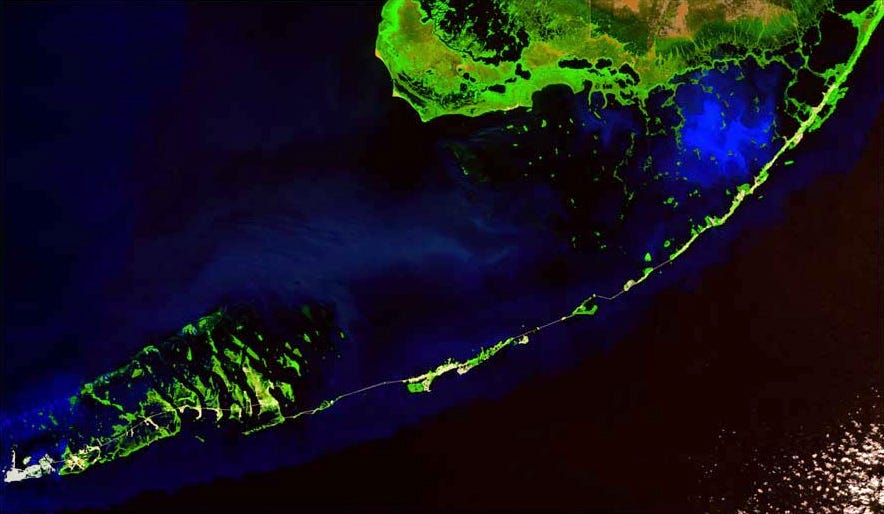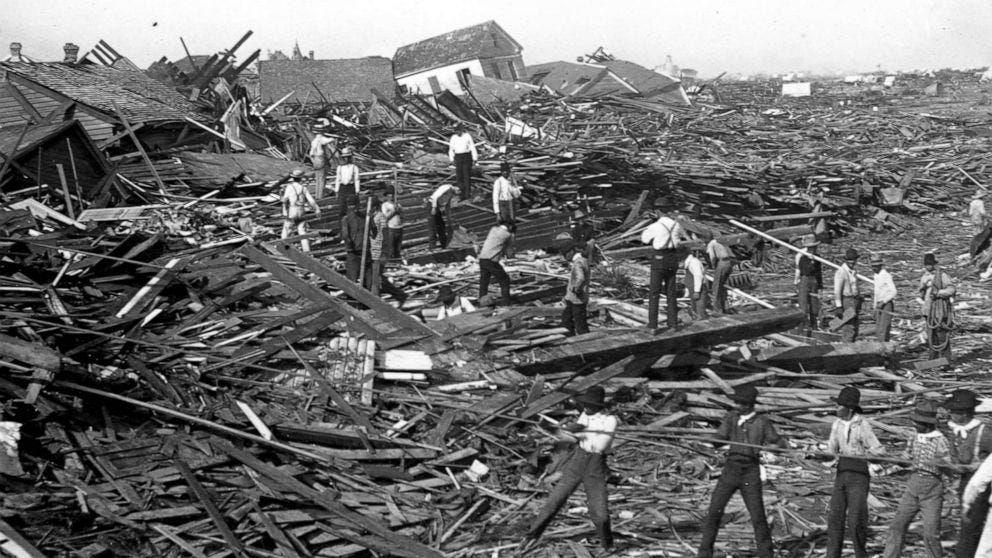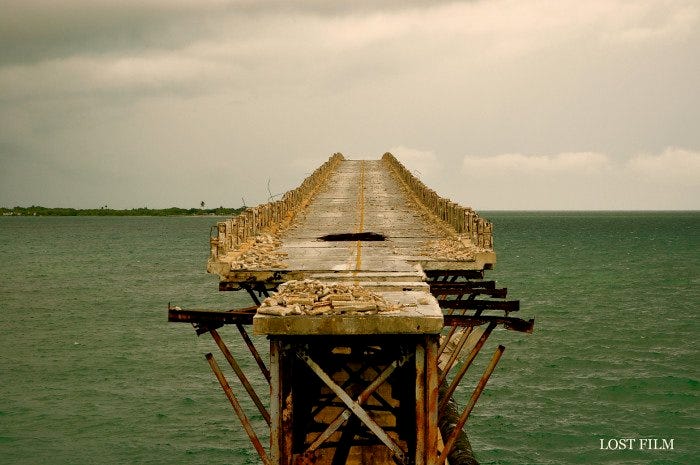Making Tracks to Paradise
“…a man’s reach should exceed his grasp or what’s a heaven for?”

The notion of “high ground” means something different in the Florida Keys. There is little that resembles a rise, let alone a hill along 160 miles of islands dotting the ocean between Miami and Key West. Standing on the hard, white coral of Pigeon Key I was reminded why it is so flat; the entire string of islands are the calcified bodies of marine life poking up from the sea.
Pigeon Key is a mere speck on the nautical chart and a couple of miles from where we are docked. You can see turquoise waters of the Gulf of Mexico to the north and deeper blue ocean of the Atlantic to the south. Ruins of the historic Florida East Coast Railway railroad track tower above, dwarfing and shading the tiny island.
A week before, I noticed Pigeon Key on the nautical chart as Glen piloted our boat through shallow water, zig zagging around countless crab pots. It was the third day of a shakedown cruise on Star Dust, an older boat we worked doggedly to refit for the Great Loop. After hot, sweaty repairs in Ft Lauderdale, we set course for the Florida Keys to get out of the city and test our repairs. I gave Pigeon Key little thought as I conversed with Marathon City Marina staff on the VHF radio and tied fenders to the stanchions to protect newly polished gelcoat.

Setting foot on Pigeon Key was a great start to appreciating the string of coral islands. The place is a living museum and reminder that the best movies are based on truth. Frayed, sepia tone photographs from the early 1900s told three stories; the rise and fall of Henry Flagler, the railroad he built from Jacksonville to Key West, and the Category 5 hurricane that destroyed it all.

Anti-elitist by nature, I am not one to admire tycoons. But Henry Flagler gets points for being born poor, then becoming the richest man in the country. The tycoon you never hear about except in Florida. He created Standard Oil with John Rockefeller, masterminded a railway system to move the oil and built houses at stations. Realizing the real fortune was in real estate, he bean building towns and cities as he laid track.
Drawn to Florida for his wife’s health, he recognized the potential for development. While constructing a railroad to Miami, he built housing and grand hotels to attract northerners to the sunshine state. Ever reaching, he envisioned and started building a railroad from Miami to Key West in 1905.
Counting on the Panama Canal
At the time, the Panama Canal was under construction and Key West was a large, working port. But there was no way to move the goods to the mainland except by ship. His plan was for ships transiting the Panama Canal to off-load in Key West then ship their goods by his railroad to the mainland. There were no roads or cars on any of the Florida Keys; travel was by boat and dependent on the weather. Looking at the long string of islands, you will see why the project seemed impossible. Tracks would have to be laid over huge swaths of ocean — something never attempted.

It seems impossible today, much less in 1905.
People dismissed Flagler’s plan as lunatic. Engineers scoffed. Friends thought he had lost his mind. But there must have been strong inner forces driving the man because undeterred, he put his massive fortune to work. Using German engineers and contract prison labor, the foundation was laid, section at a time, connecting island to island. By 1908, the only remaining piece to be built was the seven mile stretch of open water between Marathon Key and Little Duck Key.

Pouring Concrete Over the Ocean
Though Flagler’s health was failing, he was determined to arrive in Key West on the first train. Working 14-hour days, six days per week, workers mounted a “marathon” effort to complete the project before Flagler died. The City of Marathon, where our boat is docked, took its name from that final push.

Henry Flagler Waiting for His Train
The string of weathered frame buildings on Pigeon Key was the work camp for hundreds of workers during the years it took to complete the overseas span. Despite the beautiful views, fresh air and abundance of lobster, life was no picnic. Fresh water had to be transported from the mainland, even for mixing concrete. Seven years from start to finish, Flagler finally rolled into Key West on his train.

Pigeon Key Bunkhouse for Workers — Now a Museum
However, like a Greek tragedy, Mother Nature delivered a fatal blow to the railroad in 1935. It was before storms had names and weather forecasting became a science. No one understood the size of the storm until it hit them. Even today it is difficult to imagine a storm with winds of over 200 mph. Close to 500 lives were lost, and the account of one survivor left a lump in my throat.
“…it was pitch black and blowing like fury. …bodies with tree branches smashed through their chests, heads, twisted arms, and legs, … flying timber that cut like big knives. … I dug deep into the sand to keep from being blown away…”

Category 5 Storm
The tracks had already endured big storms and even hurricanes, but that Category 5 storm spelled the end for the railroad. The Florida East Coast Railway Company sold the rail to the State of Florida, which poured concrete over the tracks to make a narrow 2 lane road. It must have been nerve wracking to meet an oncoming car on that 12 foot wide strip of pavement, especially the overwater portion.
In the 1980s, a wider highway, the one used today, was built alongside it. Ruins of the original railroad bridge were left standing, parts serving as a fishing pier, though much of it just remaining in place over the water, like a long-abandoned Stonehenge, baffling all who see it.

Converted Rail Track - 12 foot Wide Two Lane Road
Glen and I climbed a wooden ramp up to the old tracks for an osprey’s view of things. We held on as wind whipped up the Atlantic Ocean and porpoises leaped through waves like dancers. I gazed down at the calmer turquoise waters of the Gulf, where enormous nurse sharks hovered near the pier. It was a strange sensation to stand in one place and feel so connected to the Gulf, the Atlantic, the past and the present. And for the first time I fully understood that Glen and I are lucky to begin our Great Loop adventure in such a truly singular place.

Postcard of Original Narrow Road Created from Track
